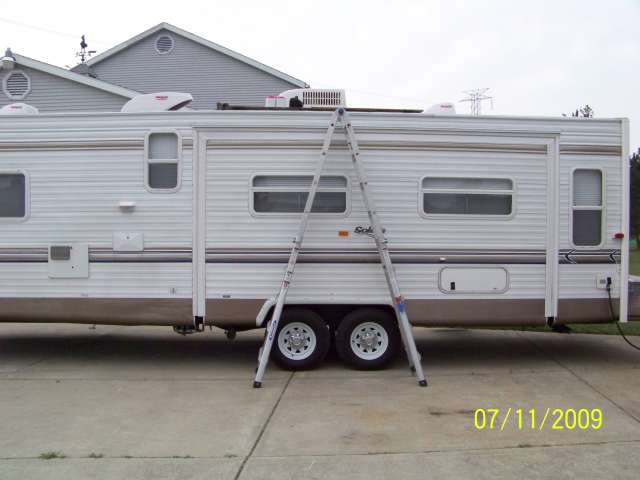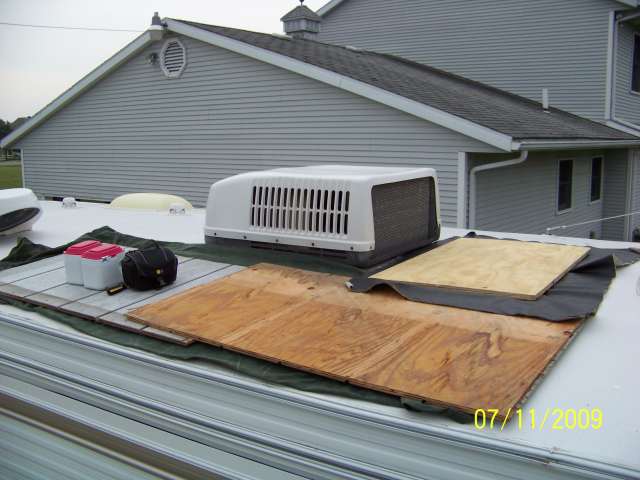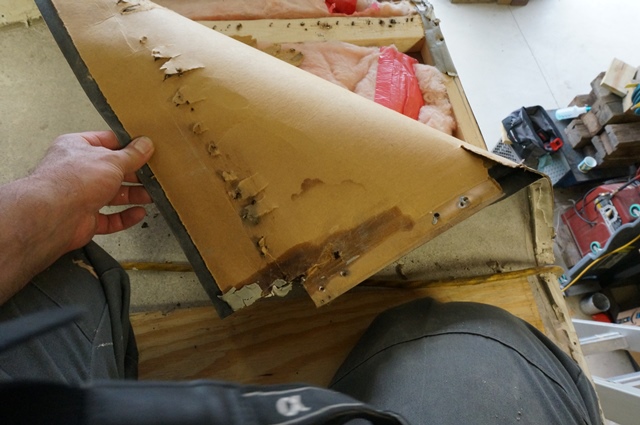Hi Mitchb,
Here are a few things to consider as you do your re-roof project.
Today's modern plywood or OSB board thickness is often only "nominal" thickness. Metric numbers replace the older true full-size thickness, and we lose about 1/32" in the thickness on average from nominal. That said, the modern-day thickness will work.
This post by ynmoose talks about roof thickness and which to use. Read that post over it has some good detail in it.
https://www.sunlineclub.com/forums/f...tch-19201.html
When we do a re-roof to a Sunline rubber roof, we will have a hard time reproducing the same heavy corrugate board they used to bond the rubber membrane to at the factory. This leaves us with a few choices in what to use. These are the choices, and they all come with trade-offs.
1/8" luan plywood. Remember, this is not a full 1/8". Sunline uses this on the campers with slide roofs, which works, but the wood rafter structure has to support such thin plywood. The lightweight here and the smaller size of the slide roof makes this work. It helps save weight and adds cargo capacity to the camper. You may get some ponding if you use 1/8" on the large main roof areas with the 1/8" sagging. Make sure you add extra support in the four corner areas of the roof if you use this thickness. And you have to add extra reinforcements under the 1/8" at tank vents, TV antennas, radio antennae etc. I would not recommend this thickness for an entire main roof. Yes, to a repair on the main roof to a smaller area under the Sunline corrugate roof, can work well with added reinforcement.
1/4" nominal exterior-rated glue plywood. I say plywood as I would not want to use OSB as it is very rough to glue down the membrane directly. Some manufacturers do glue direct to OSB; this comes down to a personal choice. Using a BC sanded rated plywood and the B side of the membrane works. AB sanded is even better if you can find it at an affordable cost. The 1/4" helps save some weight but is still a little heavier than Sunline used with the heavy corrugated board. In my view, the 1/4" is "not" a direct walk-on roof. It will snap and crackle between the rafters if you kneel on it. Some dealers use 1/4" laun plywood and call it walk-on; I have seen this done by two dealers. Again, this is a choice. You have to add extra reinforcements under the 1/4" at tank vents, TV antennas, radio antennae etc. to hold the screws for the vents etc.
3/8" nominal exterior-rated glue plywood. The same comments apply to the sanding did side and OSB as the 1/4". The difference is the added strength which also adds more weight, and you lose some cargo capacity. See the post above I linked on the weights. With 3/8", you will gain a walk-on roof, but keep it in perspective. This is not as strong as a home roof, and you need to care for the roof when carrying heavy objects around on it, like the roof AC unit. For the roof AC unit, you need a two-persons to shuffle the AC across the roof, not a one-man lift, and walk with it. The 3/8" on a camper roof will work; consider the limitations. With the 3/8" being thicker, you do not need to reinforce the small roof attachments out in the open, tank vents, etc.
7/16" or larger. This will for sure work for a walk on the roof; houses do it all the time, and they also carry packs of shingles with a person walking on it, plus other home building code requirements. But it comes with some negatives. It is heavy; a small camper is not as bad as a 30-footer, but you will lose cargo capacity. If you are on a seasonable campground and never tow the camper, losing weight capacity is not as bad; if you tow it, weight becomes a larger issue quickly.
The moldings were mentioned; you can reuse the old molding on any of the above combinations. For 3/8 and thicker, you will need to shave down the rear wall to the roof area decking of the camper to about 1/4" to make that back molding work better. I have done 3/8" without shaving, but it works better with the 4 to 6" wide taper to 1/4". 7/16 and thicker has to be shaved. This is not a major issue, just something to work through. The gutter rails and the front cap molding can all be reused. You can buy new molding if wanted not to clean up the old ones; it is just an extra cost that will be added. If you hire out the roof job, go with new moldings; it is cheaper than the cleaning labor; by doing it yourself, you can save some funds cleaning up the old ones.
Converting from the standard Sunline roof to a decked plywood roof of any thickness will be about the same work in the big picture. You have to remove all the Sunline added reinforcements to support the corrugate budboard, and you should deal with any water damage when the roof is open. Granted, 3/8" and thick is heavier to handle, but it is doable.
This comes down to weight choices and if you want to deal with using support boards and a tarp on the thinner materials.
I found using the 1/4" exterior glue-rated solid flooring sub-straight a good choice if weight is a concern. You deal with the extra support boards when servicing the roof, but it is not that bad. There are no dead pockets in the plywood, and it has a nice smooth surface for gluing; it sheds the water well and, done right, will not create water ponding areas. If you want the walk-on, consider the 3/8".
I will also give these two recommendations.
1. Screw the roof deck down with pre-counter sunk holes for a true flat screw head to the surface. This takes more time but will not budge up or bulge down the membrane.
2. Do not use staples to hold the roof deck down on a camper. Staples lift will come in time as the towing miles add up. I have seen it several times on other brands of campers or where a dealer did it quickly and easily. The staple lifts the membrane, and soon a hole will form.
If you do the plywood test over two rafters mocked up, fasten the plywood to the rafter and prevent the rafters from moving. The fasteners and the rafter not moving makes it stronger to hold the weight between the rafters.
You mentioned you are going with PVC membrane, which is not a bad choice, but let's talk about what not to do with PVC as it can crack. PVC done right is good; PVC done wrong is not. And for sure, "do not walk" on a wet PVC or TPO roof. The PVC is like ice wet; you will slide off of it. Dry is not so much an issue, just not wet or damp.
Hope this helps
John





























 Linear Mode
Linear Mode




